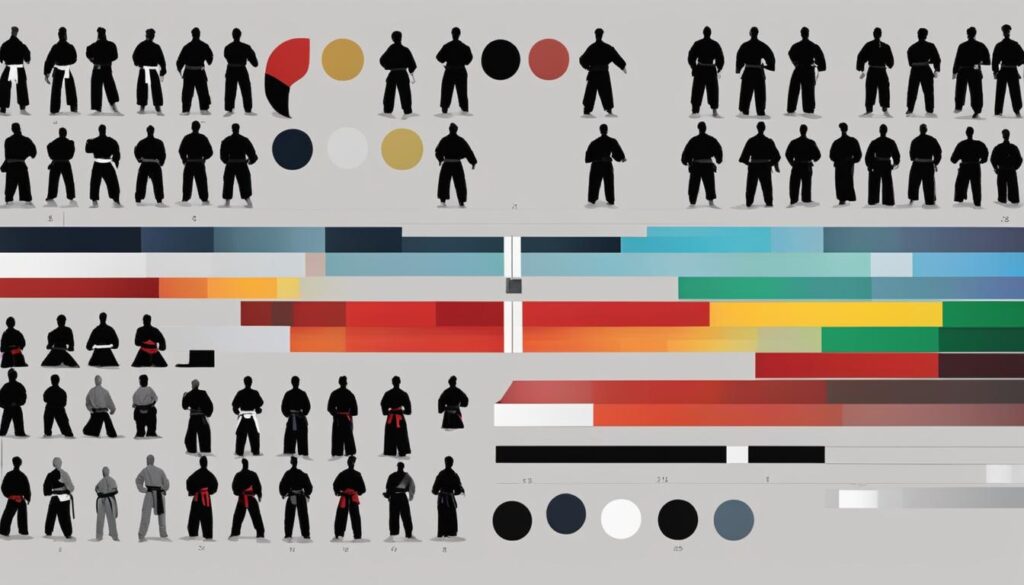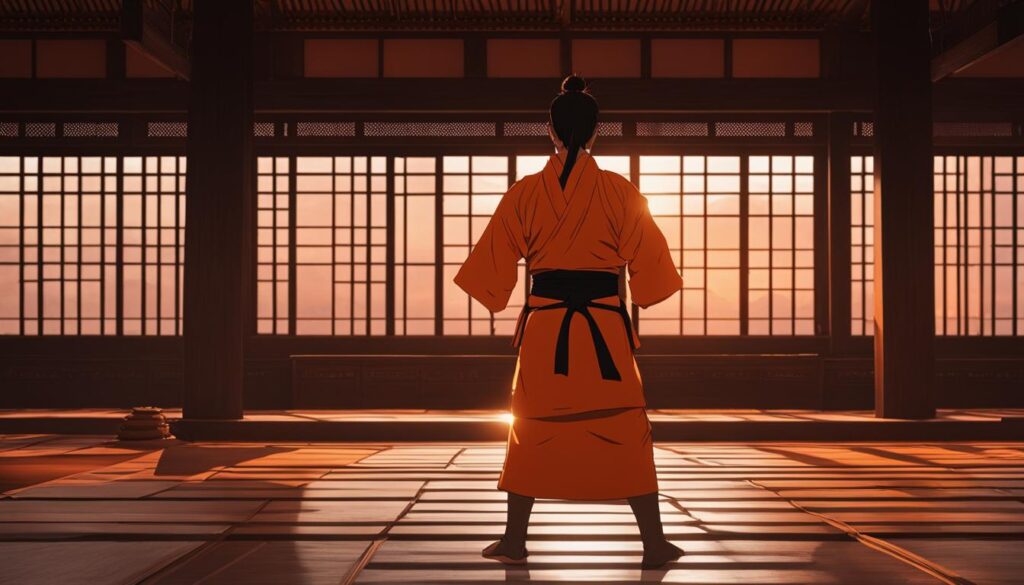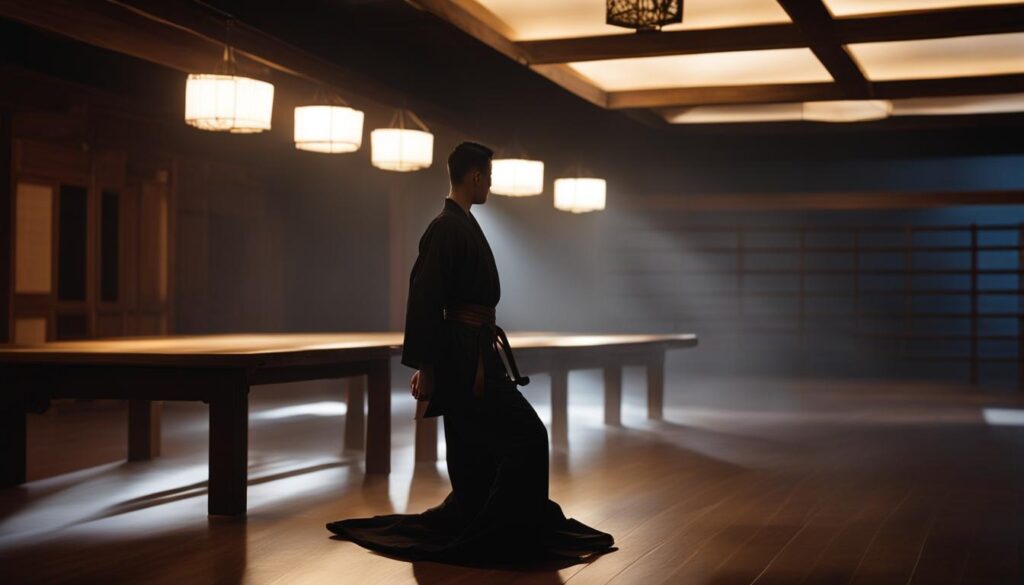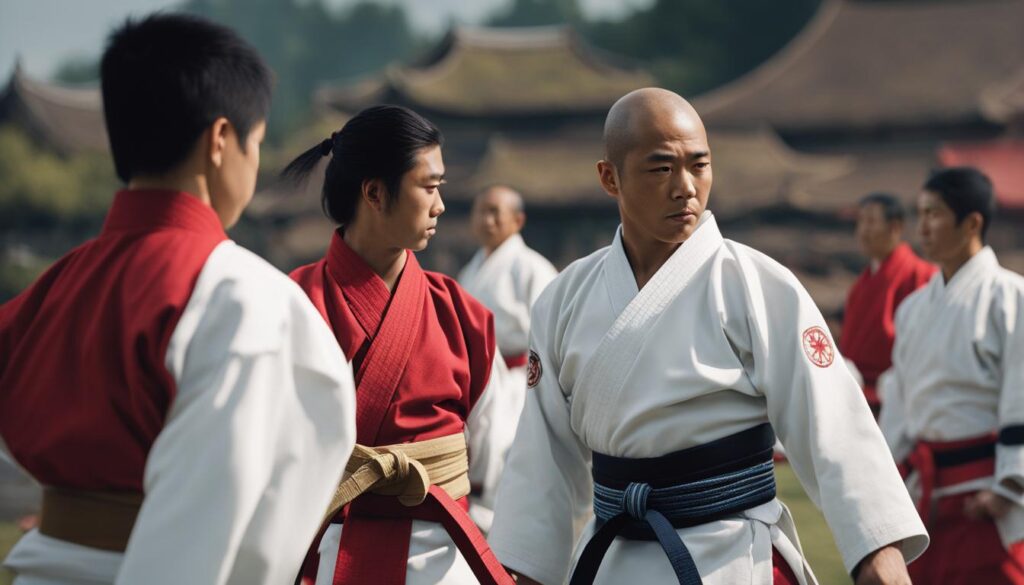Have you ever wondered what is the order of belts in karate? The karate belt ranking system is a crucial element in this martial art, indicating a practitioner’s skill level and progression. In this article, we will explore the karate belt hierarchy, the different karate belt colors, and the significance of each level. Whether you are a practitioner or simply curious about karate, this guide will provide you with a comprehensive understanding of the karate belt progression.
Key Takeaways:
- The order of belts in karate signifies a practitioner’s skill level and progress.
- Karate belt colors may vary among different styles and organizations.
- White belt is the starting point, followed by yellow, orange, green, blue, brown, and black belts.
- Belt stripes are often used to track progress between belt ranks.
- There are kyu levels (student ranks) and dan levels (black belt levels) in karate.
Belt Stripe Requirements
In some karate schools, students must meet specific belt stripe requirements before advancing to the next rank. These belt stripes serve as markers indicating the completion of different segments of the overall belt requirements. A student’s progression is often evaluated through stripe tests, which are typically conducted every two weeks.
For effective progression, it is crucial for students to exhibit mastery over specific techniques, forms, and skills associated with each belt stripe requirement. By successfully completing stripe tests, students demonstrate their readiness to tackle the challenges of the next belt rank.
All students are required to have a total of six stripes on their belts before they can undertake their test for the next rank. Each stripe represents a tangible accomplishment and signifies the student’s growth and development in karate.
By incorporating belt stripes into their curriculum, karate schools cultivate a sense of steady progression, providing students with opportunities to refine their techniques and build a strong foundation in the martial art.
The Order of Belts in Karate
In karate, the order of belts follows a well-defined progression that represents a practitioner’s growth and skill level. Each belt color signifies a different stage of development, and as practitioners advance through the ranks, they gain knowledge, hone their skills, and accumulate valuable experience in the art of karate.
The traditional order of belts in karate starts with the white belt, symbolizing purity and the beginning of the journey. White belt practitioners are beginners, eager to learn and explore the fundamentals of karate. With dedicated practice and mastery of basic techniques, they can progress to the next level.
As practitioners advance, they move through a series of colored belts, representing their increasing proficiency. The typical order of belt colors includes yellow, orange, green, blue, brown, and finally, black. Each color represents a significant milestone, signifying the practitioner’s growth and progress in karate.

Belt Progression Table
| Belt Color | Level |
|---|---|
| White | Beginner |
| Yellow | Novice |
| Orange | Intermediate |
| Green | Advanced |
| Blue | Senior |
| Brown | Expert |
| Black | Master |
This table provides an overview of the karate belt progression, highlighting the different belt colors and their corresponding levels. It is important to note that the specific order and colors of belts may vary slightly depending on the karate style and organization, but the general progression remains consistent.
As practitioners continue their karate journey, the black belt represents the pinnacle of achievement. The black belt is often seen as a symbol of mastery and expertise in the art of karate. However, it is important to remember that black belt holders are still on a continuous path of learning and refinement.
Understanding the order of belts in karate is essential for practitioners to track their progress, set goals, and strive for continuous improvement. Each belt level represents a significant milestone and serves as a testament to the practitioner’s dedication, perseverance, and growth in their martial arts journey.
Karate Belt Levels and Colors
In karate, the different belt levels are associated with specific colors, symbolizing the progression and advancement of practitioners through the various stages of their karate journey. While the exact colors may vary depending on the style or organization, the most common belt colors in karate are:
| Belt Level | Belt Color |
|---|---|
| White Belt | White |
| Yellow Belt | Yellow |
| Orange Belt | Orange |
| Green Belt | Green |
| Blue Belt | Blue |
| Brown Belt | Brown |
| Black Belt | Black |
As practitioners progress and grow in their karate skills, they advance from one belt level to the next, gaining expertise and mastering new techniques along the way.
Learning and understanding the order of belt colors in karate is crucial for practitioners to track their progress and set goals for their martial arts journey.
Kyu Levels (Student Levels)
In karate, the kyu levels, also known as student ranks, represent the early stages of practice. During these levels, the practitioner is referred to as “Mudansha”. The kyu levels progress numerically downwards, with 1st kyu (brown belt) being the highest or most advanced student rank before reaching the black belt level.
As students progress through the kyu levels, they develop a solid foundation in the fundamental techniques and principles of karate. Each level builds on the skills and knowledge acquired in the previous level, allowing practitioners to gradually advance in their martial arts journey.
While the exact requirements for each kyu level may vary depending on the style or organization, typical criteria for advancement include mastering basic strikes, kicks, blocks, and stances, as well as demonstrating proficiency in kata (forms) and kumite (sparring).
Advancing through the kyu levels not only reflects a practitioner’s growth in skill and ability, but also their dedication, discipline, and commitment to their karate practice. It is a testament to their hard work and perseverance.
By progressing through the kyu levels, students gain a deeper understanding of the principles of karate and develop the necessary foundation for further advancement in their martial arts journey.
Next, let’s take a closer look at the specific kyu levels and the skills and knowledge associated with each rank:

| Kyu Level | Description |
|---|---|
| 10th Kyu | The starting point for beginners. Introduction to basic techniques and stances. |
| 9th Kyu | Further development of basic techniques, introduction to basic combinations. |
| 8th Kyu | Continued refinement of basic techniques, introduction to kata. |
| 7th Kyu | Further development of kata, introduction to kumite (sparring). |
| 6th Kyu | Continued development of kata and kumite, introduction to basic self-defense techniques. |
| 5th Kyu | Continued refinement of kata and kumite, further development of self-defense techniques. |
| 4th Kyu | Advanced development of kata, kumite, and self-defense techniques. |
| 3rd Kyu | Further refinement of advanced techniques, continued development of physical and mental discipline. |
| 2nd Kyu | Advanced development of all techniques, preparation for black belt testing. |
| 1st Kyu | Final stage before black belt. Mastery of all techniques, advanced understanding of karate principles. |
White Belt (6th Kyu)
The white belt serves as the starting point and the foundation of a karate practitioner’s journey. It represents purity, humility, and a deep commitment to learning and personal growth through karate training.
As a beginner practitioner, wearing the white belt signifies the eagerness to acquire new knowledge, master fundamental techniques, and develop a solid understanding of the core principles of karate. It embodies the humility to embrace the role of a student and remain open to continuous improvement.
In the traditional karate system, the white belt is typically the first rank, denoting the 6th kyu level of proficiency. The term “kyu” refers to the student levels in karate, with higher numbers indicating lower ranks. As a 6th kyu practitioner, the focus is on building a solid foundation through regular practice and training.
To advance to the next rank, which is usually the 5th kyu level, a minimum period of approximately three months of active training is often required. This timeframe allows practitioners to develop a strong understanding of basic techniques, stances, and movements before moving on to more advanced training.
During the white belt phase, practitioners will learn essential skills such as proper posture, basic strikes, blocks, and kicks. They will also begin to understand the principles of distance, timing, and coordination. Training sessions may involve practicing katas (prescribed sequences of movements), basic sparring drills, and physical conditioning exercises.
At this stage, it’s crucial for practitioners to approach their karate journey with patience, discipline, and a growth mindset. By focusing on building a strong foundation as a white belt, practitioners can lay the groundwork for further progress and success in their martial arts training.
Dan Levels (Black Belt Levels)
The dan levels in karate represent advanced grades, marking the start of a practitioner’s true journey. These levels are known as “Yudansha” and indicate a higher level of skill, knowledge, and mastery in karate.
Starting from 1st dan (black belt), the dan levels progress upwards, with each level signifying additional expertise and dedication. Practitioners at these levels have demonstrated a deep understanding of the martial art and are committed to further honing their abilities.
As practitioners continue to climb the dan levels, they gain more in-depth knowledge, refine their techniques, and develop their own style within the discipline of karate. Achieving higher dan ranks is a testament to their dedication, perseverance, and continuous growth in the art form.
Shodan (1st Dan)
At the shodan level, a practitioner of karate achieves the highly esteemed 1st dan black belt. This signifies a significant milestone in their martial arts journey.
To attain the shodan rank, a practitioner must possess not only good skills but also a solid foundation in the basics of karate. They have honed their technique, developed their physical prowess, and acquired the necessary knowledge to progress beyond the beginner stages.
The journey to shodan is a testament to the practitioner’s dedication, discipline, and perseverance. It requires years of consistent training, commitment, and continuous improvement. Achieving the shodan rank is a realization of the practitioner’s potential and a symbol of their growth and progress in karate.
“The black belt is not the end, it is the beginning. It symbolizes not just skill but also a commitment to lifelong learning and personal development.”
As a 1st dan black belt, a practitioner is recognized for their dedication to karate and their ability to apply its principles and techniques effectively. They have gained a deeper understanding of the art, honed their skills, and developed their mental and physical attributes. The shodan signifies the beginning of the advanced levels of karate, where the practitioner endeavors to refine their technique, expand their knowledge, and deepen their understanding of the art.

With the shodan rank, the practitioner assumes a profound sense of responsibility and leadership within the karate community. They become role models, mentors, and instructors for aspiring karateka. The shodan rank is not just a personal achievement but also an acknowledgement of the practitioner’s ability to contribute to the growth and development of others in the martial arts.
Shinkyokushin Karate Belt System
Shinkyokushin karate has its own unique belt system that encompasses both student levels (kyu) and black belt levels (dan). This system provides a clear progression for practitioners, allowing them to track their development and growth in the martial art. The belt colors in the Shinkyokushin system range from white to black, with each color representing a different stage of a practitioner’s understanding and proficiency in karate.
The Shinkyokushin karate belt system consists of 10 kyu levels, starting with the beginner white belt and progressing through various colors. As practitioners advance through each level, they gain a deeper understanding of karate techniques, principles, and philosophies. The requirements for each belt level are well-defined, ensuring that practitioners meet specific skill and knowledge criteria before progressing to the next rank.
In addition to the kyu levels, Shinkyokushin karate recognizes black belt levels known as dan levels. These levels signify a practitioner’s mastery and expertise in karate. Each dan level represents a significant milestone on the black belt journey, providing practitioners with new challenges and opportunities for growth.
| Belt Level | Color | Description | Minimum Time |
|---|---|---|---|
| 10th Kyu | White | Beginner | N/A |
| 9th Kyu | Yellow | Novice | 3 months |
| 8th Kyu | Orange | Novice | 6 months |
| 7th Kyu | Green | Intermediate | 6 months |
| 6th Kyu | Blue | Intermediate | 6 months |
| 5th Kyu | Brown | Advanced | 9 months |
| 4th Kyu | Brown | Advanced | 12 months |
| 3rd Kyu | Brown | Advanced | 18 months |
| 2nd Kyu | Brown | Advanced | 24 months |
| 1st Kyu | Brown | Advanced | 24 months |
| 1st Dan | Black | Black Belt | 2 years as 1st Kyu |
The Shinkyokushin karate belt system is designed to encourage continuous improvement and lifelong learning in the art of karate. As practitioners progress through each belt level, they gain a deeper understanding and appreciation for the techniques, principles, and values of karate. Whether it’s the beginner white belt or the prestigious black belt, each belt represents a milestone in a practitioner’s journey towards mastery.
Black Belt With One Dash Senpai (1st Dan)
The 1st dan black belt, also known as Shodan, marks a significant milestone in the journey of a karate practitioner. It signifies their transition from a beginner to an intermediate-level black belt holder. At this stage, the practitioner has developed a solid foundation in the fundamental techniques, principles, and etiquette of karate.
Earning the 1st dan black belt reflects the practitioner’s dedication, perseverance, and commitment to their karate training. It is an achievement that demonstrates their competency in executing basic techniques, understanding the core principles of karate, and applying them effectively in combat or self-defense situations.
“Obtaining the 1st dan black belt is a momentous occasion for any karateka. It symbolizes the beginning of a new phase in their karate journey and the pursuit of higher levels of skill and knowledge.”
The 1st dan black belt holder, known as a Senpai, serves as an inspiration and mentor to lower-ranked students. They assist in teaching and guiding less experienced practitioners, sharing their knowledge and experience to support their growth within the dojo.
As a 1st dan black belt, the practitioner may be invited to participate in advanced training sessions, seminars, and competitions to further develop their skills and expand their understanding of karate. This rank also opens the door to the pursuit of higher dan levels and deeper exploration of the art.

Embarking on the journey as a 1st dan black belt in karate is an exciting and transformative experience. It represents the practitioner’s readiness to explore the limitless possibilities of karate and embark on a path of continuous learning and growth.
Required Time Limit Between Karate Belt Examinations
When embarking on a journey in karate, practitioners must understand that progression through the belt ranks requires a combination of skill, dedication, and experience. To ensure that practitioners are well-prepared for each new rank, there are specific time limits between karate belt examinations that must be followed.
These time limits serve as a crucial component of the karate training process, allowing individuals to develop their skills, knowledge, and techniques before advancing to the next rank. By imposing time constraints between examinations, practitioners have the opportunity to refine their techniques, deepen their understanding of the art, and become well-rounded martial artists.
The duration of time required between each examination will vary depending on the rank being pursued. Higher ranks may have longer time intervals to accommodate the complexity and depth of the skills being learned. However, it’s important to note that the time limits are designed to balance growth and proficiency, ensuring that practitioners have ample experience at their current level before progressing.
By adhering to these time limits, karate practitioners can truly appreciate the learning process and the journey of self-improvement that accompanies each belt rank. It is through consistent training, dedication, and patience that practitioners can maximize their potential and achieve success in karate.
History of Modern Karate Ranking
The modern karate ranking system, which utilizes belts to signify skill levels, can be attributed to the influence of Jigoro Kano, the founder of Judo. Kano introduced the belt system as a means to visually represent a practitioner’s experience and proficiency in martial arts. This innovation in ranking was later adopted by Gichin Funakoshi, the founder of Shotokan Karate, and other respected Okinawan teachers.
By implementing the belt system, Kano aimed to provide a clear and structured progression for martial arts practitioners. The different colored belts became a visual indicator of a practitioner’s dedication, progress, and level of expertise. Recognized and respected worldwide, the belt ranking system has become an integral part of karate and other martial arts disciplines.

Influences on Karate Belt Colors
The colors of the karate belts, as well as the introduction of colored belt systems in Europe, were influenced by Mikinosuke Kawaishi. Kawaishi, a Judo practitioner, believed that a visible system of different colored belts would motivate and incentivize Western students in their martial arts training. This led to the adoption of colored belt systems in karate schools outside of Japan.

Color has always played a significant role in various martial art disciplines. In the case of karate, the use of different colored belts not only signifies rank and progress but also adds a visual representation of an individual’s growth and achievements within the practice.
Mikinosuke Kawaishi’s suggestion of introducing colored belts in karate outside of Japan had a profound impact on the development of modern karate belt systems. Prior to this influence, traditional karate schools in Japan primarily used a simple two-color system, with a transition from white to black. However, Kawaishi’s idea revolutionized the way karate practitioners perceive and advance through different levels of skill and expertise.
By incorporating colored belts into the ranking system, Kawaishi provided a clear visual indication of a practitioner’s progress, creating a stronger sense of achievement and motivation. Western students responded positively to this new structure, as it allowed them to track their advancements more easily and stay motivated throughout their karate journey.
Today, colored belt systems are widely adopted in karate schools worldwide, ensuring that students can recognize their own growth and set clear goals for improvement. The belt colors themselves often vary slightly between different karate styles and organizations, but the underlying concept remains consistent.
Whether one is just starting their karate training as a white belt or has achieved the prestigious black belt, the colored belt system provides a tangible representation of their dedication, skill, and progression in the martial art.
Conclusion
By understanding the order of belts in karate, practitioners can gain a clear roadmap for their progression in the martial art. Starting with the white belt, each subsequent belt represents a new level of skill, knowledge, and experience. As they advance through the different belt colors, practitioners can track their progress, set goals, and strive for mastery.
The karate belt progression serves as a meaningful symbol of a practitioner’s dedication, perseverance, and growth. It signifies not only the development of physical abilities but also the cultivation of discipline, focus, and self-confidence. Each belt level presents new challenges and opportunities for personal growth, making the karate journey an enriching and transformative experience.
Whether a practitioner is starting with a white belt or aiming for the coveted black belt, the karate belt progression provides a structured framework for learning and improvement. It is a testament to the practitioner’s commitment and serves as a motivation to continue the pursuit of excellence in the art of karate.
FAQ
What is the order of belts in karate?
The order of belts in karate typically starts with a white belt and progresses through yellow, orange, green, blue, brown, and black belts.
How does the karate belt ranking system work?
The karate belt ranking system signifies a practitioner’s skill level and progress in the martial art. As practitioners advance, they earn higher belt ranks based on their knowledge, skills, and experience.
What are the belt colors in karate?
The most common belt colors in karate are white, yellow, orange, green, blue, brown, and black. However, the exact colors may vary among different karate styles and organizations.
What are the different levels of karate belts?
The different belt levels in karate represent different stages of a practitioner’s development and signify their increasing knowledge, skills, and experience. The levels include white, yellow, orange, green, blue, brown, and black belts.
What are kyu levels in karate?
Kyu levels in karate, also known as student ranks, represent the early stages of practice. The practitioner is referred to as “Mudansha” during these levels. The kyu levels progress numerically downwards, with brown belt (1st kyu) being the highest student rank before black belt.
What does the white belt symbolize in karate?
The white belt is the starting point or the beginning of the karate journey. It represents the purity, humility, and commitment of a beginner practitioner who is eager to learn and grow through karate.
What are dan levels in karate?
Dan levels in karate are considered advanced grades, signifying a higher level of skill, knowledge, and mastery. Practitioners holding a dan level are called “Yudansha.” The dan levels start from 1st dan (black belt) and progress upwards.
What is Shodan in karate?
Shodan, or 1st dan, is the first level of black belt in karate. At this level, a practitioner is recognized for having good skills and a solid foundation in the basics of karate.
How does the belt system work in Shinkyokushin karate?
Shinkyokushin karate follows a specific belt system with 10 kyu levels (student levels) and dan levels (black belt levels). The belt colors range from white to black, with each level representing a different stage of a practitioner’s development and understanding of karate.
How long does it take to earn a black belt in karate?
The time it takes to earn a black belt in karate varies depending on the individual’s dedication, training frequency, and the specific requirements set by their karate style or organization. It often requires several years of consistent practice and training.
What is the history of the karate belt ranking system?
The modern karate ranking system, including the use of belts to represent different levels of skill, can be traced back to Jigoro Kano, the founder of Judo. Kano introduced the belt system to indicate a practitioner’s experience and level of proficiency, which was later adopted by Gichin Funakoshi and other Okinawan teachers.
Why are there different belt colors in karate?
The introduction of colored belt systems in karate was influenced by Mikinosuke Kawaishi, a Judo practitioner. Kawaishi believed that a visible system of different colored belts would motivate and incentivize Western students in their martial arts training. This led to the adoption of colored belt systems in karate schools outside of Japan.
How much time should pass between karate belt examinations?
There are specific time limits between karate belt examinations to ensure practitioners have sufficient training and experience before advancing to the next rank. The duration required between each examination varies depending on the rank and the specific requirements set by the karate style or organization.
